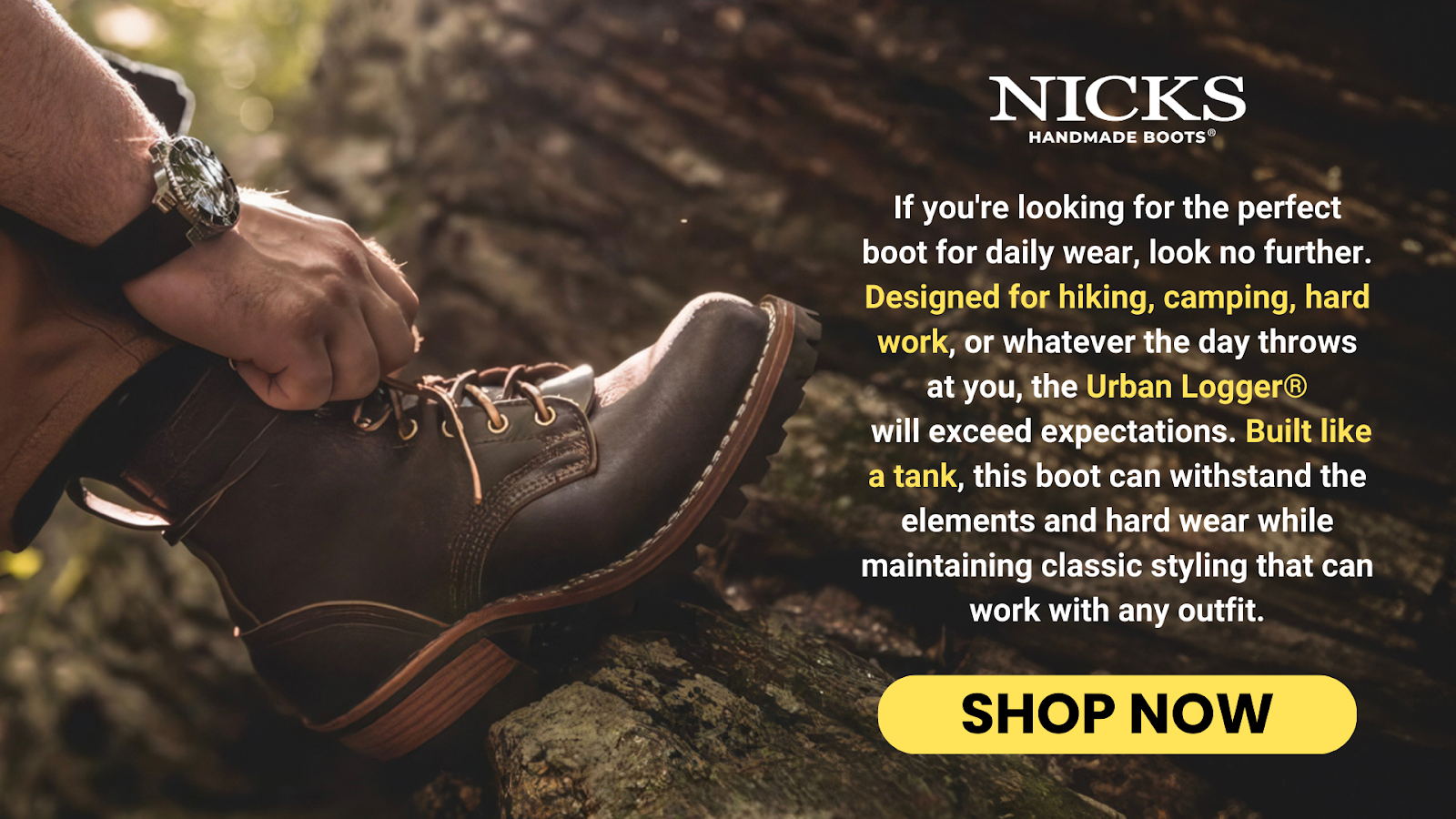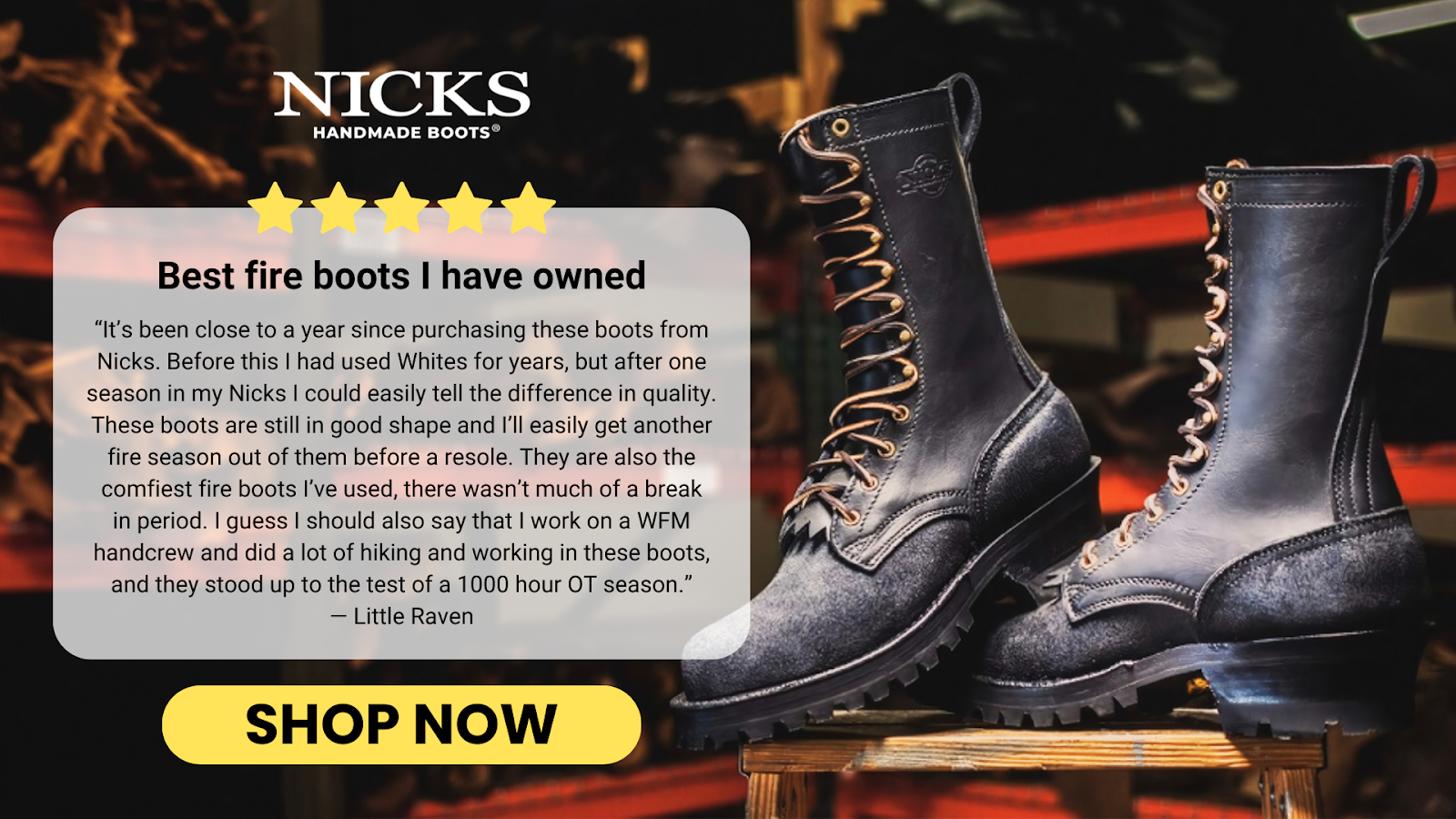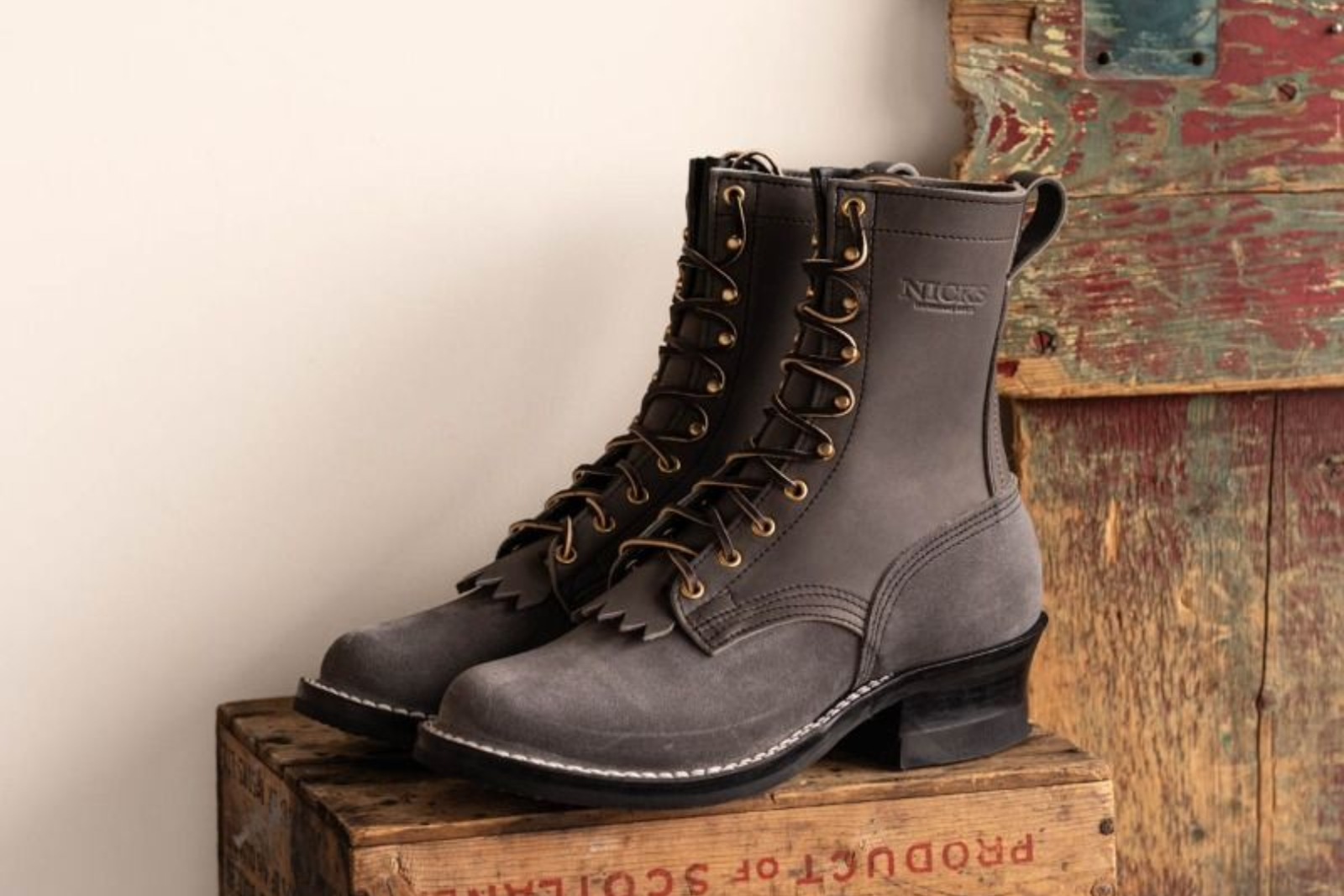Key Takeaways:
- Effective Application: Choosing the right waterproofing product and correctly applying it ensures the best protection for leather boots.
- Maintenance Tips: Regular cleaning, conditioning, and reapplication of waterproofing treatments maintain boot longevity and performance.
- Common Mistakes: Avoiding common waterproofing mistakes, such as applying on dirty boots or using incorrect products, can prevent damage and enhance boot functionality.
At Nick’s Boots, we’ve built our reputation on crafting exceptional, handmade leather boots that stand the test of time and the rigors of hard work. As industry leaders with decades of experience, we understand that the longevity and performance of a leather boot isn’t just about high-quality craftsmanship; it’s also about how you care for them.
Whether you’re trudging through muddy job sites or facing unexpected downpours, maintaining dry, comfortable feet is crucial for both comfort and foot health. In this guide, we will walk you through the essential steps to waterproof your leather work boots effectively. Join us as we discuss the best practices that will protect and prolong the life of your trusted leather boots.

Understanding Leather And Its Needs
Leather is a natural material that requires care to maintain its strength, flexibility, and aesthetic appeal. Over time, exposure to water can cause the leather to become stiff, crack, or even rot. This deterioration not only affects the appearance of your boots but can also compromise their structural integrity. Waterproofing is vital because it adds a protective layer that repels water and prevents these damaging effects.
Additionally, waterproofing helps in maintaining the breathability of the leather, ensuring that moisture from within (like sweat) can escape while preventing external water from penetrating. This balance is crucial for comfort and the long-term health of the leather. By understanding these needs, you can better appreciate the importance of the waterproofing process and ensure that your leather boots stay functional and stylish.
Choosing The Right Waterproofing Products
Selecting the appropriate waterproofing product is crucial for effective protection of your leather boots. Here’s a detailed overview of the three most common types of waterproofing products—waxes, creams, and sprays—each offering unique benefits and suited for different leather types and conditions:
Waxes
Waxes are known for providing a thick, durable layer that deeply penetrates the leather, creating a strong barrier against water and other elements. They are particularly ideal for boots used in harsh, rugged conditions where maximum protection is required. While very effective, waxes can slightly alter the texture and color of the leather, often giving it a richer and darker finish. This change can be beneficial for those looking to enhance the aesthetic of their boots while also increasing their durability.
Creams
Creams offer a more user-friendly application compared to waxes and are excellent for those who prioritize maintaining the leather's natural appearance. They provide a good balance by nourishing the leather, which helps to preserve its flexibility and prevent cracking, while still offering a moderate level of water resistance. Creams are absorbed quickly and do not significantly alter the leather’s color or texture, making them a preferred choice for routine maintenance and light waterproofing needs.
Sprays
Waterproofing sprays are the most convenient option for quick applications and are particularly suitable for boots that face light to moderate wet conditions. They apply evenly and typically do not change the leather's appearance, which makes them attractive for maintaining the original look of the boots. However, sprays may not provide as long-lasting protection as waxes or creams and generally require more frequent reapplication to maintain their effectiveness.
Preparation Before Waterproofing
Proper preparation of your leather work boots is key to ensuring the waterproofing process is successful. Here's a detailed step-by-step guide to preparing your boots:
Clean The Boots
Start by removing any dirt, mud, or debris using a soft brush or damp cloth. For stubborn dirt, consider using a leather cleaner that is specifically formulated for your type of leather to ensure it cleans without damage. Avoid harsh cleaning agents that can strip away natural oils and lead to drying or cracking of the leather. This step is crucial for clearing any contaminants that might hinder the absorption of waterproofing agents.
Dry The Boots
After cleaning, allow your boots to air dry naturally at room temperature. Place them in a well-ventilated area away from direct sunlight and heat sources like radiators or hairdryers. These heat sources can cause the leather to crack or warp, affecting both the appearance and durability of your boots. Proper drying is essential to prepare the leather for an even application of waterproofing products.
Condition The Leather
Once the boots are completely dry, apply a quality leather conditioner. This step is vital as it replenishes essential oils and makes the leather supple, preventing it from becoming brittle or cracking over time. Conditioning helps maintain the elasticity and integrity of the leather, ensuring it remains receptive to waterproofing products. A well-conditioned boot not only absorbs waterproofing more effectively but also retains its protective coating longer.
Check For Damage
Before applying any waterproofing treatment, carefully inspect your boots for any signs of damage such as cracks, splits, or loose seams. Address these issues promptly—repairing or reinforcing as necessary—to ensure a thorough and effective application of the waterproofing treatment. This helps prevent water from seeping into vulnerable areas, which could lead to further damage and reduce the overall effectiveness of the waterproofing.
Applying Waterproofing Products
Once your boots are clean, dry, and conditioned, you're ready to apply the waterproofing product. Follow these detailed instructions to ensure a thorough and effective application:
Choose A Well-Ventilated Area
It is crucial to work in a well-ventilated area to safeguard your health, particularly when using spray products that can emit strong fumes. Good ventilation helps disperse these fumes and reduces the risk of inhalation, which can be harmful over prolonged exposure. If working indoors, open windows or use a fan to aid in air circulation.
Test The Product
Before committing to applying the product over the entire surface of the boots, conduct a spot test on a small, inconspicuous area. This test will help you determine if there will be any adverse reactions such as discoloration or damage to the leather, ensuring that the product is suitable for your specific type of boots. Allow the test spot to dry completely before deciding to proceed.
Apply The Product Evenly
- For waxes and creams: Use a clean cloth or a soft brush to evenly distribute the product across the leather surface. Focus particularly on seams, joins, and other potential entry points for water. An even application ensures that no areas are overly saturated, which could lead to stiffness or uneven coloring.
- For sprays: Hold the can approximately 6 inches away from the boots to ensure a fine, even mist coats the surface. Spray in a sweeping motion to cover all exterior surfaces thoroughly, preventing any uneven spots that could lead to leaks.
Allow Time To Absorb
Give the boots ample time to absorb the waterproofing treatment; at least 20-30 minutes is recommended. During this period, avoid touching or moving the boots, as this can lead to uneven coverage or smearing of the product.
Buff Or Wipe Off Excess
Once the product has been absorbed, use a soft cloth to buff or gently wipe off any excess product from the surface of the boots. This step is important to prevent buildup and to ensure a smooth, even finish that not only looks good but also enhances the leather’s protection.
Repeat If Necessary
A second application may be necessary for boots that will be exposed to extremely wet conditions or if the first application appears uneven. Waiting for the first layer to fully absorb and dry before applying a second layer ensures maximum effectiveness and durability of the waterproofing.
Drying And Post-Treatment Care
After applying the waterproofing treatment, it's crucial to allow your boots to dry properly and to follow up with regular maintenance to keep them in top condition:
Drying The Boots
Let the boots dry naturally in a well-ventilated area away from direct heat sources such as radiators, stoves, or direct sunlight. This natural drying process can take anywhere from 24 to 48 hours, depending on ambient conditions like humidity and airflow. Avoid the temptation to speed up the drying process using artificial heat, as rapid drying can lead to the leather becoming stiff, brittle, or even cracking, which diminishes both its aesthetic and protective qualities.
Regular Maintenance
Even after waterproofing, leather boots require consistent care to maintain their condition and extend their lifespan. It's important to clean and condition the leather periodically, especially after exposure to harsh conditions like mud, snow, or salt, which can degrade leather over time. Additionally, reapply the waterproofing treatment as needed, typically every few months or after extensive use in wet environments, to renew the protective barrier and keep the boots resistant to water and other elements.
Storing The Boots
Proper storage is essential for preserving the shape and condition of your boots when they are not in use. Store your boots in a cool, dry place to prevent mold and mildew growth, which can damage the leather. Use boot trees or stuff them with newspaper to help maintain their shape and absorb any residual internal moisture. This not only helps the boots retain their form but also prevents creases and cracks from developing in the leather, ensuring they are ready for use whenever needed.
Common Mistakes To Avoid
To ensure the best results when waterproofing your leather work boots, it’s important to be aware of some common mistakes that could undermine your efforts:
- Not Cleaning Boots Properly: Applying waterproofing products on dirty boots can trap dirt and other particles, potentially damaging the leather and reducing the effectiveness of the waterproofing.
- Using the Wrong Waterproofing Product: Not all products are suitable for all types of leather. Using the wrong type can lead to damage or inadequate protection. Always follow the manufacturer’s recommendations.
- Applying Too Much Product: Over-applying can clog the pores of the leather, affecting its breathability and comfort. It's essential to apply a thin, even layer.
- Neglecting to Test the Product: Skipping the patch test might lead to unexpected reactions, such as discoloration or damage to the leather.
- gnoring Drying Times: Rushing the drying process or not allowing enough time between applications can prevent the product from setting properly, reducing its effectiveness.
By avoiding these mistakes, you can maximize the effectiveness of your waterproofing and ensure your leather boots last longer and perform better.
Final Thoughts
Waterproofing your leather work boots is a straightforward process that can significantly extend their lifespan and enhance their performance. By choosing the right waterproofing products, preparing the boots properly, and applying the treatment correctly, you can protect your boots from water damage and other environmental factors. Regular maintenance, including cleaning and reapplying waterproof products, will keep your boots in the best condition, ready for any challenge.
Remember, taking the time to care for your boots not only protects your investment but also ensures your comfort and safety in various working conditions or outdoor activities. Follow this guide to keep your leather work boots durable, comfortable, and water-resistant.

Read also:
Frequently Asked Questions About Waterproofing Leather Work Boots
Can I waterproof new leather boots immediately after purchase?
Yes, it's often advisable to waterproof new leather boots before their first use to protect them from the start, especially if you anticipate using them in wet conditions.
How often should I reapply waterproofing treatments to my leather boots?
Typically, reapplication should occur every three to six months, depending on how frequently the boots are used and the conditions they are exposed to.
Does waterproofing leather boots make them completely waterproof?
While waterproofing greatly enhances the water resistance of leather boots, it does not make them completely waterproof. Prolonged or extreme exposure to water may still penetrate.
Can I use the same waterproofing product on suede or nubuck leather boots?
No, suede and nubuck require specific types of waterproofing products designed for their delicate surface. Using standard leather waterproofing products can damage these materials.
Is there a difference in waterproofing effectiveness between colored and natural leather boots?
The color of the leather does not affect the effectiveness of the waterproofing, but colored leather may require a patch test to ensure the product does not affect the dye.
What is the best way to dry leather boots after they get wet?
The best way is to let them air dry naturally away from direct heat sources. Stuffing them with newspaper can help absorb moisture from the inside.
Are there any environmental concerns with using waterproofing sprays?
Some sprays contain volatile organic compounds (VOCs) that can be harmful to the environment. Look for eco-friendly products that offer lower VOCs.
Will waterproofing my boots affect their breathability?
Quality waterproofing should not significantly affect breathability, especially if applied correctly in thin, even layers.
Can regular household items be used for waterproof boots?
While DIY methods exist, such as using beeswax, commercial products specifically designed for leather boots typically offer more reliable and lasting protection.
What's the best way to store waterproofed leather boots?
Store them in a cool, dry place and avoid plastic bags which can trap moisture. Using a boot tree or shapers can help maintain their form.





































